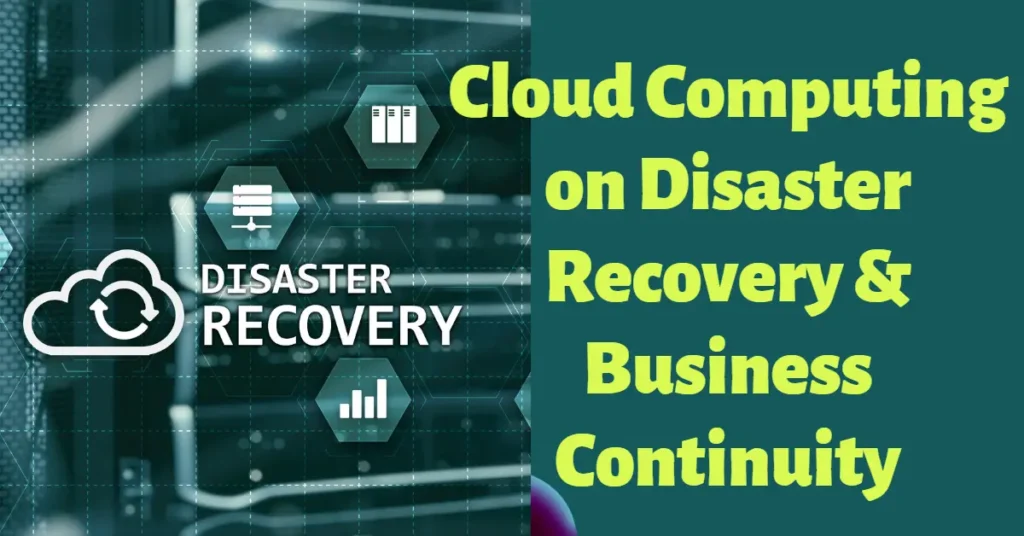Cloud computing has revolutionized the way businesses approach disaster recovery and business continuity planning. In the past, disaster recovery and business continuity planning were often seen as costly and time-consuming endeavors that required significant investments in hardware, software, and personnel. However, with the advent of cloud computing, these processes have become more affordable, efficient, and effective.
What is Business Continuity
Business continuity in cloud computing refers to the ability of an organization to maintain its critical operations and services during and after a disruptive event. This includes the ability to quickly recover from disasters, such as natural disasters, power outages, or cyber-attacks, and to ensure that business processes can continue to function normally.
Cloud computing offers several features and services that can help businesses to achieve business continuity, such as data backup and recovery, disaster recovery as a service (DRaaS), and high availability. These features and services can help businesses to minimize downtime, reduce the impact of disruptive events, and ensure that critical operations and services can continue to function normally.

What is Disaster Recovery
Disaster recovery in cloud computing refers to the process of protecting and restoring an organization’s critical data, applications, and systems in the event of a disaster. This can include natural disasters, power outages, cyber-attacks, and other disruptive events. In the context of cloud computing, disaster recovery typically involves creating and maintaining a secondary copy of data and systems in a remote location, such as a cloud-based data center, so that they can be quickly restored in the event of a disaster.
Disaster recovery in cloud computing can take many forms, such as:
- Backup and recovery, where data is backed up to a remote location and can be quickly restored in the event of a disaster.
- Disaster recovery as a service (DRaaS), where a third-party provider offers disaster recovery services and infrastructure on a subscription basis.
- High availability, where systems are designed to automatically failover to a secondary system in the event of a disruption, minimizing downtime.
Disaster recovery in the cloud allows businesses to be more agile, flexible, and resilient to unexpected events. By having their data and systems stored and maintained remotely, they can minimize the risk of data loss, while also reducing the time and cost associated with traditional disaster recovery methods.
Roles of Cloud Computing on Disaster Recovery and Business Continuity Planning
Scaling Resources
One of the key benefits of cloud computing in disaster recovery and business continuity planning is the ability to quickly and easily scale resources. In the event of a disaster, businesses can quickly spin up additional virtual machines and storage to ensure that their systems and data remain accessible and available. This is a significant advantage over traditional disaster recovery solutions that often require significant lead times to acquire and deploy additional hardware. Cloud computing allows for flexibility and scalability during a crisis, enabling businesses to increase their computing resources to meet the needs of the situation. Additionally, this allows for businesses to reduce their overall IT costs by paying only for what they use.
Replicating Data and Systems
Another advantage of cloud computing in disaster recovery and business continuity planning is the ability to replicate data and systems across multiple locations. This ensures that if one location is affected by a disaster, the data and systems can be quickly restored from a secondary location. This is particularly important for businesses that operate in areas that are prone to natural disasters, such as hurricanes, earthquakes, or floods. This allows businesses to maintain their operations in case of any disaster, as the data is replicated in multiple locations. This also ensures that the data is safe and secure, as it is stored in multiple locations.
Cost Savings
Cloud computing also offers a number of cost savings in disaster recovery and business continuity planning. By leveraging the economies of scale of cloud providers, businesses can reduce their capital expenditures and operating expenses. Additionally, cloud providers often provide disaster recovery and business continuity services as part of their standard offerings, which can further reduce costs. This allows businesses to reduce their overall IT costs by not having to invest in hardware and software for disaster recovery. Additionally, the cloud providers often have experienced staff that manage the disaster recovery and business continuity services, which allows businesses to reduce their staffing costs.
Advanced Features
Cloud computing also enables businesses to implement advanced disaster recovery and business continuity features such as automation, orchestration, and self-service recovery. This allows businesses to quickly and easily restore systems and data without relying on IT personnel. Automation allows for the recovery process to be done quickly and efficiently, without human intervention. This reduces the chances of human error and increases the chances of a successful recovery. Additionally, orchestration allows for the recovery process to be done in a specific order, ensuring that all the systems are recovered in the correct order. Self-service recovery allows for the businesses to recover their systems and data without the need for IT personnel, which reduces the time it takes for the recovery process to be completed.
In conclusion, cloud computing has dramatically changed the way businesses approach disaster recovery and business continuity planning. It offers a cost-effective, efficient, and scalable solution that can be easily tailored to meet the specific needs of each business. By leveraging the power of cloud computing, businesses can ensure that they are prepared for the unexpected and can quickly restore their systems and data in the event of a disaster.



